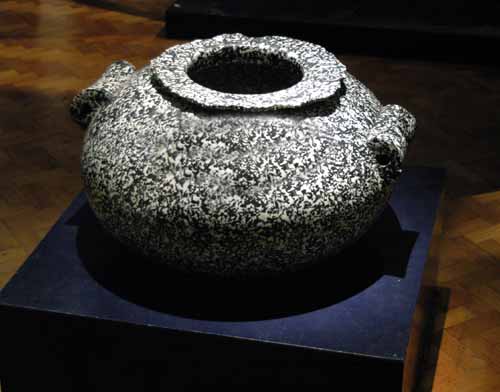
Black diorite vase from Hierakonpolis. Approx. 2 feet high. Pre-dynastic period c.3200 BC. Manchester Museum.
Stone vases are a distinctive feature of Old
Kingdom tomb goods. Some forms existed in prehistoric times, but in several
ways, the prehistoric work differs from that of dynastic times. Few types of
vase run from one age to the next, although a continuation in form can be seen
from the Archaic Period through to the Old Kingdom.
The material is often a clear guide to the date. For example, a translucent
diorite vase will almost always date to the Old Kingdom. Some shapes such as the
cylinder jar and bowls with re-curved rims are derived from pottery forms, but
other stone forms are quite independent, although a general resemblance can be
seen between them and the pottery of each period. The cylinder jar, perhaps the
only class which is descended from prehistoric times, is derived from the
wavy-handled pottery. Other early designs include upright vases in barrel, squat
and collared form; different kinds of bowls and handled vases also occur, and
imitation shells carved in diorite are derived from the earlier shells used to
contain eye-paint.
Stone vases were usually made by grinding. The form was roughly chipped and the
surface worked down with sand-blocks. The interior was hollowed out with a drill
using different methods for different forms. Generally a large core was drilled
out from the centre, and the interior was then ground out with a block, using
sand or emery. in some cases, difficulties in producing certain forms were made
easier by making a vase in two halves. The drill was weighted with stones to
provide extra motive power and the cutting head of these drills was a flint
blade shaped like a blunt arrowhead.